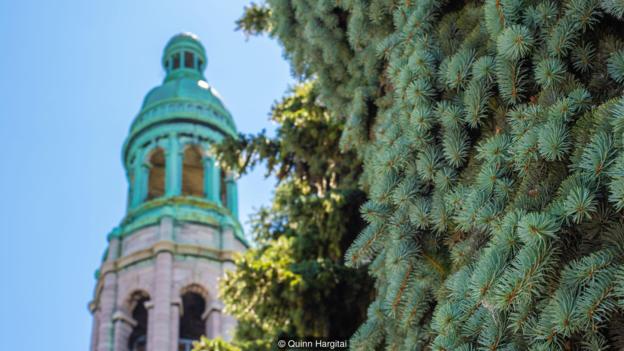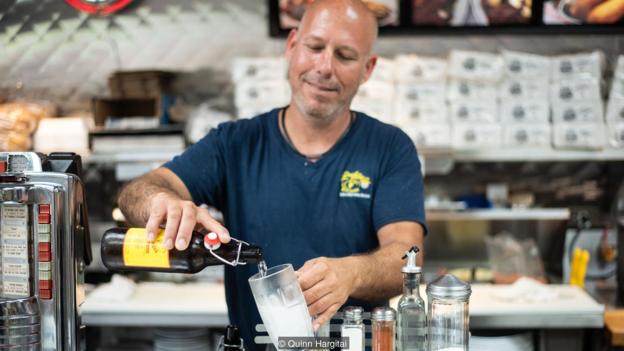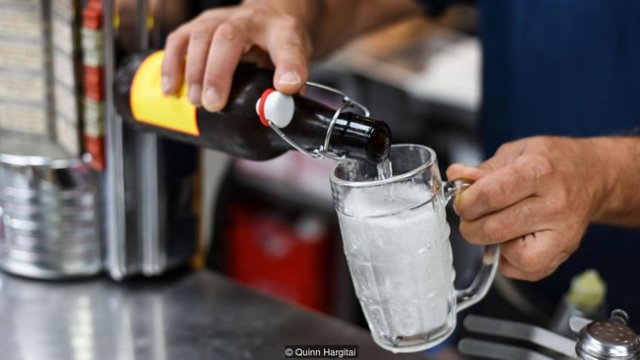In a little poutine shop on the eastern side of Montreal’s Canal de Lachine, I breathed a sigh of relief as the server placed a heavy, dark-brown bottle on my table. Beads of condensation were already rolling down its side, stirring within me an odd sense of sympathy at having found a companion who was perspiring as profusely as I was.
So far, I had found the European influence in Quebec’s largest city quite charming: the chatter of French in cafes; the freshly baked brioche for breakfast; the murmur of street-side jazz wafting through the summer air. But, although I’d usually consider it admirable, the one European sensibility I was currently not enjoying was the pronounced dearth of air conditioning. I had arrived in the middle of one of Montreal’s worst heatwaves in decades.
I raised the bottle and poured its contents into a frosted mug. The clear, effervescent brew had scarcely foamed to the top before it was at my lips. As I eagerly took my first sip, I was immediately hit with the unmistakable, biting taste of conifer – like a liquefied Christmas tree. This was my first bière d’épinette, or spruce beer.
Despite its name, the drink contains a negligible amount of alcohol; it’s more like a root beer (a sweet, North American soft drink) than a lager or ale. Even so, on such a sweltering day, it wouldn’t feel a stretch to say the drink saved my life. As legend has it, this beer has something of a reputation for saving lives.
Dany Roy is the proprietor and spruce brewmaster of this poutine shop, Paul Patates. Though factory-produced spruce beer is commercially available in many Canadian supermarkets, Roy’s particular brew has gained something of legendary status among locals. As far as Roy knows, his restaurant is one of a few remaining places in Canada where one can find authentic, homemade spruce beer. Brewed and bottled in the shop’s small back room, Roy’s spruce beer is still made ‘the old fashioned way’, through fermentation and yeast (though the process is stopped while the alcohol content is minimal). Though the recipe has remained relatively unchanged over the last century, Roy claims the story of spruce beer’s origins stretches back even further.

“First of all, we all know that the spruce beer was made by the [indigenous peoples]. They used it like a medicine,” he explained. Of course, the spruce beer used by the First Nations peoples was a far cry from the fizzy pop found in Roy’s shop. Theirs was a decoction made by boiling the ground bark and leaves of coniferous trees. One of the earliest written mentions of the drink and its purported medicinal properties came from the accounts of French navigator Jacques Cartier. In the account of Cartier’s exploration of the St Lawrence River in the winter of 1536, an unnamed sailor wrote of a vicious bout of scurvy, caused by a Vitamin C deficiency, that ravaged the expedition.
“The sickness broke out among us accompanied by most marvellous and extraordinary symptoms,” the author wrote. “For some lost all their strength, their legs became swollen and inflamed, while the sinews contracted and turned as black as coal… of the 110 men forming our company, there were not 10 in good health so that no-one could aid the other, which was a grievous sight considering the place where we were.”
Just as things looked darkest for Cartier and his men, salvation came from the local Iroquois tribe in the form of a life-saving elixir. Made from the boiled bark and evergreen tips of a regional conifer, the concoction reportedly cured every man bold enough to try it. “A whole tree as large and as tall as any I ever saw was used up,” the account reads, “and produced such a result that had all the doctors of Louvain and Montpellier been there, with all the drugs of Alexandria, they could not have done so much in a year as did this tree in eight days.”
Named ‘Anneda’ by the local tribes, the exact species of the tree is still a mystery, though it is thought to have been the white cedar or the balsam fir. Regardless of the species, evergreen trees in general contain surprisingly high concentrations of Vitamin C in their needles.
Though the decoction written about in the accounts of Cartier’s voyage is more a herbal tea than the effervescent beverage Roy sells, Roy considers this to be one of the earliest forms of modern spruce beer. “That’s where it all started,” Roy said. “After that, people transformed it. They started fermenting it.”

The fermented iteration of spruce beer enjoyed a stint of fame, rising to prominence after it was praised and popularised by famed nutritionist James Lind in his Treatise on Scurvypublished in 1753. After observing its effects on sailors afflicted with scurvy, Lind wrote:
“Spruce beer, made of the black spruce, either fresh or dried, or from its essence, is an excellent medicine. This beer must be drank daily, and the parts affected with the eruption [of scurvy] bathed with it night and morning.”
Lind’s writings inspired the British Navy to make the elixir a standard ration for long sea voyages. It was even lauded by Captain Cook in his written accounts of his voyages across the world. Cook’s own recipe, which he penned in his first volume of A Voyage to the South Pole and Round the World, called for a decoction of boiled spruce branches and tea leaves, with the addition of molasses and yeast to initiate the fermentation process. He found the brew to be so effective that in later writings he listed it as part of a daily regimen said to ‘remove all seeds of scurvy from our people’.
However, nutrient-rich as spruce tips are, it’s now known that their Vitamin C content diminishes significantly with boiling and is virtually non-existent after prolonged fermentation. In spite of Cartier’s experience with the drink, the fermented, alcoholic brews of Cook and Lind were not likely to have any curative properties.
Roy’s modern version is yet another adaptation, as he no longer boils spruce sprigs but instead uses spruce essence, which he claims makes for a cleaner flavour. Still, even though the recipe and preparation methods have changed since the time of Cartier, the myth surrounding spruce beer’s purported healing qualities has endured.
“I wouldn’t say that it can cure people, but sure enough people who come here in the winter swear that they don’t catch a cold, all because they’re drinking the spruce beer,” Roy said, a note of scepticism in his voice.
Though the wonders of spruce beer may never have reached international renown, it nevertheless maintained its hold in Canada – specifically in Quebec, as Roy explained. “People here used to brew it in their bathtubs, back in the ‘20s and ‘30s,” Roy said, “When they finished brewing they put it in heavy bottles, usually Champagne ones, and brought it to their roofs to ferment. When the bottles started popping, that’s how you knew the spruce beer was ready.”
Roy’s own brand of spruce beer has become a cultural icon. Roy’s father Paul opened the restaurant in the 1950s, but the recipe Roy uses has been around since the 1800s. Using no factory machines or carbonators, Roy does his brewing alone in a small, temperature-controlled room in the back of the restaurant. He’s remarkably secretive about his process, but he did indulge me with the knowledge of two key ingredients: oil extracted from black spruce, just as Lind recommended; and the water from Montreal, which Roy claims to have just the right purity level to produce his spruce beer’s unique taste.
For those outside Montreal hoping to get a taste of the legendary brew, options are scant. Roy’s spruce beer has a short shelf life, so it must be enjoyed fresh. What’s more, the heavy brown bottles are for more than just show; they’re the only bottles strong enough to withstand the pressure built up during fermentation, but if not properly temperature-controlled, they run the risk of exploding. In order for customers to qualify for a special delivery, Roy said that they must have extenuating circumstances.
“There was a man in Newfoundland who was dying of cancer. His last wish was to taste real spruce beer one more time, so his wife contacted me,” Roy recalled. “It’s usually a problem to ship it by plane because of the pressure, but I made some phone calls and there was a pilot who agreed to keep it in the cockpit with him. In the end, he was able to have it before he passed. That was the only time we ever shipped it this way.”
For most people, a trek to Montreal is all they need to do to get their hands on a genuine spruce beer. Although no promises can be made about whether it can cure any ailments, there’s still something to be said for the invigorating taste of fresh spruce on a hot summer day in Canada.


